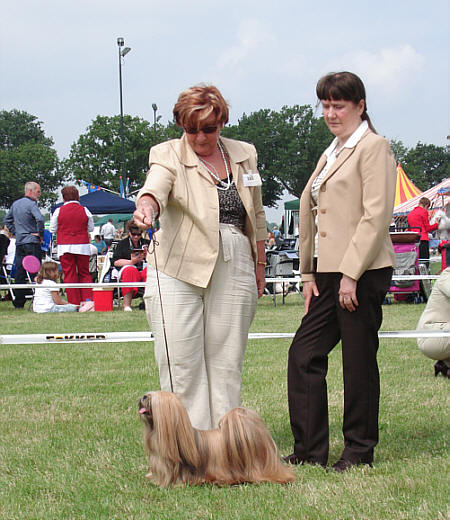In Denmark at the Danish Lhasa Apso club annual birthday show in Koege, EL Minja's Xivas won his last CAC for the Danish Champion title under breed specialist Mrs. Beverly Drake from the USA.49 Lhasas were entered, congratulations for his owner Jette Yeoman!

Judge Beverly Drake, CH EL Minja's Xivas with Jette
Lhasa Apso "Candy" wins 3 times Best of Breed back to back!
last weekend 2 titels: German Champion and Sieger Baden-Wurttemberg
8 November At the International Dogshow Stuttgart in Germany organized by Landesverband Baden-Wurttemberg, 6185 dogs were entered overal, Candy won Best female with the CAC/CACIB and Best of Breed the Lhasa Apso breed judge was Mr Walter Jungblut from Germany. Thank you judge Mr Jungblut.
Candy Best of Breed at Stuttgart, Judge Mr Walter Jungblut and Sylvia
Our Lhasa Apso female Am.Ch. Nuseng Candy Kisses Singdu "Candy" won Best of Breed, Best in Group 3 at Bleiswijk Int. !
2 November The International Bleiswijk Dogshow in Holland organized by KC Dordrecht, 2538 dogs entered, Candy won Best female with the CAC/CACIB and Best of Breed the Lhasa Apso breed judge was Mr Hans Boelaars from Holland.

In the honorary ring Candy won Best in Group 3 judged by Mr Pieter Burema also from Holland. Thanks both judges, Frank and Sylvia.
Best in Group judging at Bleiswijk 2008
Our Lhasa Apso female Am.Ch. Nuseng Candy Kisses Singdu "Candy" won Best of Breed, Best in Group and 6th Best in Show !
26 october The famous Bi-yearly "De Utrecht international Dogshow" in Holland, 2507 dogs entered,CH EL Minja's Jewel of Tibet won best male with CAC/CACIB, my junior female JCH EL Minja's Jawaharlal Nehru (aka Katie) in junior class, obtained 1 ex. and JCAC. Candy won Best female with the CAC/CACIB and Best of Breed the Lhasa Apso breed judge was Mrs Wil Schrander from Holland.
In the honorary ring Candy won Best in Group judged by Mrs Monique Van Brempt from Belgium.The Best in Show was judged by Dr Wilfried Peper from Germany and it was an honor to be finished 6th Best in Show. Thanks to all the judges and my friends for the assistance, Frank.
Foto © Wim van Vugt
Best in Group "De Utrecht" Judge Mrs Monique Van Brempt and Frank
"Candy" is bred from all EL Minja's Lhasas, 2nd generation EL Minja's bred in the USA by Fran.

